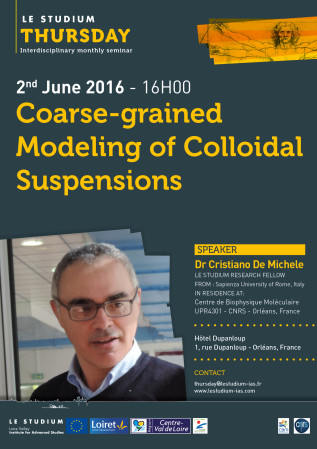Dr Cristiano De Michele

From
“Sapienza” University of Rome - IT
In residence at
Center for Molecular Biophysics (CBM) / CNRS - FR
Host scientist
Project
“Cell biology from the colloid physics perspective: a computational study of biomolecular interactions mid-way between the test-tube and the cell”
The cell interior is an amazingly complex and crowded medium. Up to 40 % of its available volume is swarming with hundreds of thousands of biomolecules of all type and size, highly structured in specific compartments separated by different membranes and filled up with small organelles and a tight web of cytoskeletal structures. How proteins can possibly manage to find their unique binding partners in such an environment of mind-bogging complexity, looking more as a bustling city than a dull biological background, is still one of the most elusive puzzles in science.
Thanks to the most recent technical advances in imaging and single-particle tracking techniques, paralleled by tremendous progress in computational approaches, it is now generally believed that the environment itself is a key factor in shaping the biochemical processes that it hosts. However, it is very difficult to interpret experiments on biomolecular transport and association performed in living cells, due to the plethora of unknown and spurious effects that are likely to affect the measurements, arising from all the processes running in parallel to the one under scrutiny and most probably intertwined with it in unknown ways. The common solution to these strongly impeding disadvantages is the test tube. However, in order to perform experiments under the required conditions, one pays the price of studying a pale copy of the process of interest, distilled to such dilute and controlled conditions to become with great probability an utterly different process.
Publications
In this paper we introduce a fully flexible coarse-grained model of immunoglobulin G (IgG) antibodies parametrized directly on cryo-EM data and simulate the binding dynamics of many IgGs to antigens adsorbed on a surface at increasing densities. Moreover, we work out a theoretical model that allows to explain all the features observed in the simulations. Our combined computational and theoretical framework is in excellent agreement with surface-plasmon resonance data and allows us to establish a number of important results. (i) Internal flexibility is key to maximize bivalent binding, flexible IgGs being able to explore the surface with their second arm in search for an available hapten. This is made clear by the strongly reduced ability to bind with both arms displayed by artificial IgGs designed to rigidly keep a prescribed shape. (ii) The large size of IgGs is instrumental to keep neighboring molecules at a certain distance (surface repulsion), which essentially makes antigens within reach of the second Fab always unoccupied on average. (iii) One needs to account independently for the thermodynamic and geometric factors that regulate the binding equilibrium. The key geometrical parameters, besides excluded-volume repulsion, describe the screening of free haptens by neighboring bound antibodies. We prove that the thermodynamic parameters govern the low-antigen-concentration regime, while the surface screening and repulsion only affect the binding at high hapten densities. Importantly, we prove that screening effects are concealed in relative measures, such as the fraction of bivalently bound antibodies. Overall, our model provides a valuable, accurate theoretical paradigm beyond existing frameworks to interpret experimental profiles of antibodies binding to multi-valent surfaces of different sorts in many contexts.

